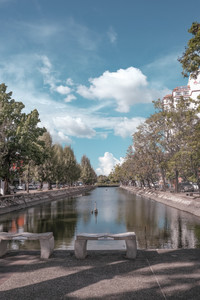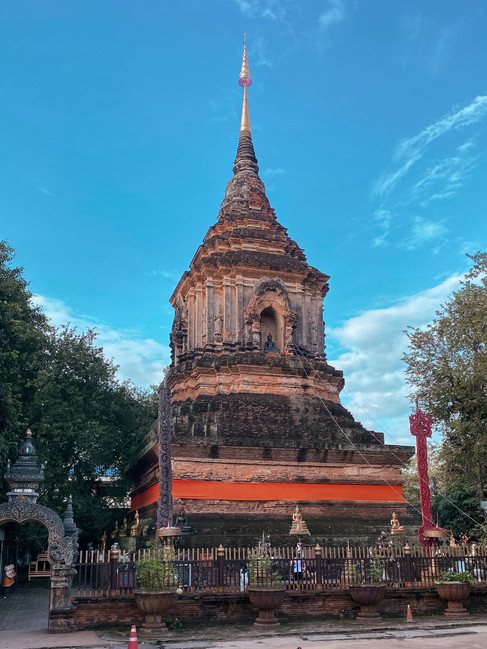Exploring Chiang Mai: The New City with Ancient Roots
- Katy M

- May 30, 2024
- 7 min read
The name "Chiang Mai" translates to "new city" in Thai. It was given this name because it was built after Chiang Rai, its neighboring city which was until then the largest city and capital of the northern kingdom of Thailand. Since then, Chiang Mai has become a very central city, the second-largest in Thailand, and the capital of the northern province of Thailand.
We traveled to Chiang Mai for five days as part of a longer trip to Thailand. Chiang Mai is a beautiful city, with numerous temples, an ancient area rich in history, alongside newer neighborhoods, all imbued with an atmosphere of authentic Eastern charm. This was my second visit to the city, and it completely captured my heart once again.

Accommodation in Chiang Mai: A Tale of Old City Charm
There are four central areas where most tourists stay in the city. The Old City, surrounded by an ancient moat and wall, the Night Bazaar area located east of the wall, the Mae Ping River area in the Wat Ket district east of the Old City and the Night Bazaar, and the hipster Nimman neighborhood west of the Old City. All four areas are touristy, but each offers a different atmosphere.
We chose to stay in the Old City at the amazing Tamarind Village Hotel. This boutique hotel with relatively few rooms offers one of the best breakfasts I've ever had, luxurious spa facilities, and impeccable service. Located in the heart of the Old City, just minutes walk from all the attractions in a preserved ancient building, the hotel is stunningly beautiful, with a giant tamarind tree at its center and lush foliage in every corner creating a magical feeling of a small, pastoral village that makes you forget you're right in the heart of the city.
Note that we traveled with a baby, and if I could think of one drawback to this hotel, it's that it doesn't have a kids' club. While there is a pool and families with children and babies were present, if this is something important to you, it's worth considering.
Getting Around in Chiang Mai: The Grab Way
Navigating Chiang Mai, we opted for Grab taxis. Operating similarly to Uber, it connects you with local drivers based on availability. It works seamlessly in the city and is much cheaper than hailing taxis on the street.

Exploring Chiang Mai: What to Do
Day Trip to Doi Inthanon Reserve - Doi Inthanon Reserve is named after the highest mountain in Thailand, located within its boundaries. It's one of Thailand's most famous national parks, just an hour's drive from the city center of Chiang Mai. The reserve boasts impressive waterfalls, hiking trails, villages, and, of course, Doi Inthanon Mountain itself. Day trips to the reserve are offered by various tour agencies in the city. These full-day excursions include several stops along the way and can be taken as part of a group or privately.
During the day trip, you'll stop at two impressive and gigantic waterfalls, visit a local village nestled near impressive rice fields and coffee plantations, and explore two pagodas, the King and Queen Pagodas. These imposing structures with modern designs were built to honor the King and Queen of Thailand. Finally, you'll reach the summit of Doi Inthanon Mountain.
Keep in mind that the reserve is relatively high, so the weather there differs from the city itself. At the summit, it can be chilly with a higher chance of rain, so it's advisable to be prepared in advance.
Doi Suthep Temple - Located about a thirty-minute drive from Chiang Mai, the Doi Suthep Reserve is named after Doi Suthep Mountain, which lies within its boundaries. The reserve offers several hiking and trekking trails, along with numerous waterfalls and viewpoints. However, the most famous and intriguing attraction here is the beautiful Wat Phra That Doi Suthep temple, perched atop Doi Suthep Mountain, offering breathtaking panoramic views. It's highly recommended to visit the temple at sunset.
Kercher Elephant Eco Park - Generally, there are several elephant sanctuaries in the Chiang Mai area. Visiting such a sanctuary is a kind of contribution; the money paid contributes to its continuation and the well-being of the elephant population in Thailand. Today, all elephant sanctuaries open for tourist visits are aimed at the care and protection of the northern Thai elephant population and are not for riding or other activities that were common in the past.
The Kercher Elephant Eco Park, where we chose to visit, is located approximately a 45-minute drive from the city and is run by a family that cares for five elephants, ranging from a 35-year-old adult to a two-and-a-half-year-old juvenile.
The elephants are cared for by Karen tribe members from northern Thailand, with each elephant having a dedicated caregiver who tends to its needs. Upon arrival at the sanctuary, visitors receive a detailed explanation of the elephants' lives at the park, their diet, and the site's history. The elephants roam freely in the jungle surrounding the sanctuary.
Throughout the day, visitors trek with the elephants in the sanctuary area, have the opportunity to feed them, participate in bathing them in the river, and, most importantly, marvel at the incredible strength of these amazing animals.
Cooking Workshop at Mama Noi Cooking School - Participating in a Thai cooking class while in Thailand is a must for me if you consider yourself a fan of Thai cuisine. There are countless cooking schools across the country, and we chose to attend a workshop with one of the well-known schools in Chiang Mai, Mama Noi.
The cooking workshop lasts for about half a day, starting with a hotel pickup where we stop at the local market and receive explanations about the unique local ingredients used in Thai cuisine. Throughout the day, each participant chooses one dish from three different categories - soup, curry, and main course - to prepare during the workshop.
The school is located in a beautiful compound surrounded by lush greenery, with an impressive herb garden that we tour during our visit. Every aspect of the class is an experience, from the meticulous planning and management to the professional explanations delivered in the most accessible and clear manner imaginable.
During the workshop, we learn about each ingredient, the preparation methods, and the key flavor profiles to focus on. At the end of the cooking session, we of course enjoy the fruits of our labor and receive a recipe book to take home. 😊
Exploring Food with A chef's Tour - A food tour is a must-have experience for me in every city I visit, and Chiang Mai was no exception. I always say that through the food history of a particular place, you learn a lot about its history and its people.
We chose to go on a tour with A Chef's Tour. The four-hour tour focused on northern Thai cuisine. Throughout the evening, we tasted around 15 dishes, some served at local restaurants and others local delicacies, including unique fruits commonly eaten by locals.
This tour is an intriguing experience, with some parts possibly challenging and not suitable for everyone. It's advisable to come prepared and inquire beforehand if you're not adventurous with food. On the other hand, such a tour exposes you to the "real Thailand," not the cuisine tailored to Western palates but the authentic Thai cuisine. You learn about cooking and hospitality customs, shopping and consumption habits, and even the kitchen itself, which is a blend of Asia and Central America.
Markets
The Sunday Market - The Sunday Market of Chiang Mai is, in my opinion, the highlight and definitely the most worthwhile market we visited during our trip to Thailand and perhaps in all my travels around the world. The market kicks off from around 5:00 PM until around 11:00 PM, with the main street in the old city closed to traffic from noon and filled with countless stalls. Here you can find countless stalls selling jewelry, clothing, souvenirs, handicrafts, and basically everything you can think of. Additionally, there are several food courts spread across the temple compounds in the adjacent streets. You can spend hours wandering through this market, and it's definitely recommended!
Night Bazaar - The Night Bazaar operates every day starting from 5:00 PM and is located east of the old city and west of the Ping River. Here you can find souvenir stalls, jewelry, bags, clothing, and of course, countless food stalls with a large food court right in the center of the market.
Chinatown Night Bazaar - A bustling and massive night market in the Chinatown area of Chiang Mai. The main focus of the market is food stalls, where you can also find souvenirs and clothing, but honestly, I would say the highlight is for food enthusiasts. If you're craving a dish of silkworms, fried crickets, or grilled skewers, this is definitely the place to visit.
Restaurants
Nun‘s - A small local restaurant specializing in Khao Soi, which is the flagship dish of Northern Thailand. Khao Soi is a curry noodle soup with boiled and fried egg noodles, topped with meat/fish/tofu. Here we had the most successful Khao Soi in my opinion.

Baan Landai Fine Thai Cuisine - A recommended local restaurant with a rich and unique menu. Note that it's worth asking for recommendations; there were amazing dishes and some that we liked less, and we regretted not asking for guidance.
Kao Soy Nimman - A recommended restaurant by locals specializing in the Kao Soy dish. It offers a rich menu of Kao Soy soups with every possible addition you can think of: meat, fish, seafood, tofu, mushrooms, and more.
Redbox Dining Room - A recommended upscale fine dining restaurant by locals. It offers dishes from the Thai kitchen with a meticulous twist and amazing service. This restaurant is romantic, and intimate, and requires reservations.
Saruda Finest Pastry - Offers a variety of pastries and cakes with unique flavors, many of which have a Japanese twist. For example, a lemon and yuzu tart with gold leaves or a matcha pistachio cake. Located right across from Roast8ry Cafe, so I recommend combining a visit to both.
Roast8ry Lab - An award-winning, hipster café. They serve amazing local coffee with a variety of interpretations, such as milk ice cubes with whiskey and more.
.png)












































































































































Comments